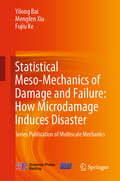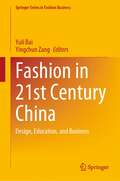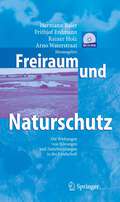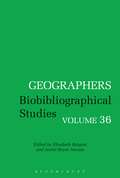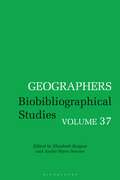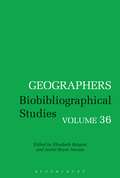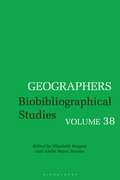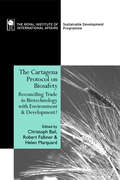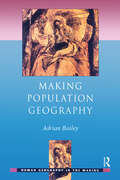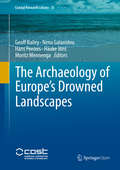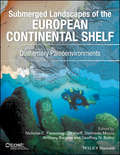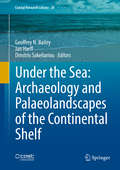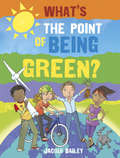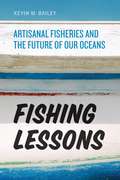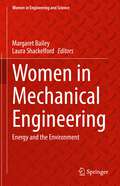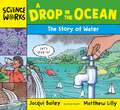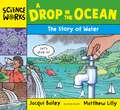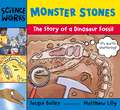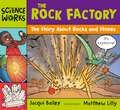- Table View
- List View
Statistical Meso-Mechanics of Damage and Failure: Series Publication of Multiscale Mechanics
by Yilong Bai Mengfen Xia Fujiu KeThis book introduces a trans-scale framework necessary for the physical understanding of breakdown behaviors and presents some new paradigm to clarify the mechanisms underlying the trans-scale processes. The book, which is based on the interaction of mechanics and statistical physics, will help to deepen the understanding of how microdamage induces disaster and benefit the forecasting of the occurrence of catastrophic rupture. It offers notes and problems in each part as interesting background and illustrative exercises.Readers of the book would be graduate students, researchers, engineers working on civil, mechanical and geo-engineering, etc. However, people with various background but interested in disaster reduction and forecasting, like applied physics, geophysics, seismology, etc., may also be interested in the book.
Fashion in 21st Century China: Design, Education, and Business (Springer Series in Fashion Business)
by Yuli Bai Yingchun ZangThis book explores the dynamic landscape of fashion in China since the beginning of the 21st century through an integrated perspective. The book considers key questions related to the changes in China’s fashion dynamics driven largely by the shifts in the mindset of Chinese consumers due to the current sociocultural contexts. To provide an understanding of these important shifts, this three-part monograph pays close attention to the new generation of Chinese fashion designers and consumers. The book explores in detail related topics such as, how today’s Chinese consumers relate to foreign brands, the meaning of apparel brands as identity symbols or cultural signs to contemporary young consumers, the attractiveness of Western fashion designers and brands in the eyes of current Chinese consumers as compared to past consumers, and how brands could adapt to the online-centered consumption behavior. The book serves as an insightful update on the Chinese fashion landscape for researchers, practitioners and passionate followers of its evolution.
Freiraum und Naturschutz: Die Wirkungen von Störungen und Zerschneidungen in der Landschaft
by Hermann Baier Frithjof Erdmann Rainer Holz Arno WaterstraatFlächenverbrauch sowie Störungen und Zerschneidungen in der Landschaft führen für viele Tier- und Pflanzenarten zu einschneidenden Konsequenzen. Erhöhte Mortalität, Dezimierung von Lebensräumen, verringerter Genaustausch und Verinselung der Restpopulationen erfordern eine weit über die einzelne Population oder den einzelnen Biotop hinausgehende Betrachtungsweise. Durch Verknüpfung von geographischen, verhaltensbiologischen und populationsökologischen Ansätzen wird hier erstmals ein geschlossener Überblick über das Thema vorgelegt. Anhand von Beispielen werden die Einflüsse von Störungen und in den einzelnen Wirkebenen wie Verhalten, Habitatnutzung und Population erläutert. Schlussfolgerungen für die Umwelt-, Landschaftsplanung, den Artenschutz und die Eingriffsregelung bieten neben der Vermittlung eines in sich geschlossenen Theoriegebäudes auch dem Praktiker im Naturschutz eine wertvolle Hilfe für die tägliche Arbeit.
Geographers: Biobibliographical Studies, Volume 36 (Geographers)
by Elizabeth Baigent André Reyes NovaesGeographers: Biobibliographical Studies, Volume 36 focuses on 20th-century Britain and 19th- and 20th-century France. Six essays on individual geographers are complemented by a group article which describes the building of a French school of geography. From Britain, the life of Sir Peter Hall, one of the most distinguished geographers of recent times and a man widely known outside the discipline, is set alongside memoirs of Bill Mead, who made the rich geography of the Nordic countries come alive to geographers and others in the Anglophone world; Michael John Wise and Stanley Henry Beaver, who made their mark through building up the institutions where academic geography was practised and through teaching; and Anita McConnell, whose geographical training shaped her museum curation and studies of the history of science. From France, the individual biography of André Meynier is juxtaposed with group article on the first five professors of geography at Clermont-Ferrand. These intellectual biographies collectively show geography and geographers profoundly affected by wider historical events: the effect of war, particularly the Second World War, and the shaping of post-war society. They show the value of geographical scholarship in elucidating local circumstances and in planning national conditions, and as a basis for local, national, and international friendship.
Geographers: Biobibliographical Studies, Volume 37 (Geographers)
by Elizabeth Baigent André Reyes NovaesGeographers: Biobibliographical Studies, Volume 37 explores the concept of distinction in geography. Through the lives of six geographers working in Brazil and Réunion, it investigates what distinction consists of, how we identify and celebrate it and how it relates to quotidian practices in the discipline.The volume highlights the continuing importance of biography and the International Geographical Union in recording and assessing distinction. It also considers the relevance of personal networks for the circulation and translation of distinguished geographical knowledge, and how this knowledge can underpin applied projects and critical appraisal of geographical scholarship, both at a national and sub-national level. Gendered notions of distinction are also addressed, particularly through June Sheppard, who found limited recognition for her work as a result of gendered expectations within the discipline and society at large.By reflecting on how we locate distinguished geographers and tell their histories, Geographers: Biobibliographical Studies, Volume 37 makes an important contribution to fostering less canonical work in historical geography.
Geographers: Biobibliographical Studies, Volume 36 (Geographers #Volume 28)
by Elizabeth Baigent André Reyes NovaesGeographers: Biobibliographical Studies, Volume 36 focuses on 20th-century Britain and 19th- and 20th-century France. Six essays on individual geographers are complemented by a group article which describes the building of a French school of geography. From Britain, the life of Sir Peter Hall, one of the most distinguished geographers of recent times and a man widely known outside the discipline, is set alongside memoirs of Bill Mead, who made the rich geography of the Nordic countries come alive to geographers and others in the Anglophone world; Michael John Wise and Stanley Henry Beaver, who made their mark through building up the institutions where academic geography was practised and through teaching; and Anita McConnell, whose geographical training shaped her museum curation and studies of the history of science. From France, the individual biography of André Meynier is juxtaposed with group article on the first five professors of geography at Clermont-Ferrand. These intellectual biographies collectively show geography and geographers profoundly affected by wider historical events: the effect of war, particularly the Second World War, and the shaping of post-war society. They show the value of geographical scholarship in elucidating local circumstances and in planning national conditions, and as a basis for local, national, and international friendship.
Geographers: Biobibliographical Studies, Volume 37 (Geographers #Volume 28)
by Elizabeth Baigent André Reyes NovaesGeographers: Biobibliographical Studies, Volume 37 explores the concept of distinction in geography. Through the lives of six geographers working in Brazil, North America, Europe and Réunion, it investigates what distinction consists of, how we identify and celebrate it and how it relates to quotidian practices in the discipline.The volume highlights the continuing importance of biography and the International Geographical Union in recording and assessing distinction. It also considers the relevance of personal networks for the circulation and translation of distinguished geographical knowledge, and how this knowledge can underpin applied projects and critical appraisal of geographical scholarship, both at a national and sub-national level. Gendered notions of distinction are also addressed, particularly through June Sheppard, who found limited recognition for her work as a result of gendered expectations within the discipline and society at large.By reflecting on how we locate distinguished geographers and tell their histories, Geographers: Biobibliographical Studies, Volume 37 makes an important contribution to fostering less canonical work in historical geography.
Geographers: Biobibliographical Studies, Volume 38 (Geographers #Volume 28)
by Elizabeth Baigent André Reyes NovaesWomen are the exclusive focus of the 38th volume of Geographers. For the first time in the serial's history, the entire volume is devoted to important work of distinguished female geographers, amply demonstrating how these scholars' professional lives enrich the discipline's history. It also illustrates how reading and writing their biographies not only expands our understanding of geography's past, but points to its more diverse future.The collection includes biographies of Doreen Massey, winner of geography's 'Nobel prize', the prix Vautrin-Lud, for her remarkable contribution to geography and neighbouring disciplines which discovered the importance of space through her work; Helen Wallis, geographer and historian of cartography who for many years had charge of the UK's foremost collection of maps; Alice Saunier-Seïté, who applied her geographical training and formidable energy to teaching and educational reform in France; Isabel Margarida André, who lived through a turbulent political period in her native Portugal and meticulously investigated its effect on women and political geography; and the many women who helped to create the UK's first Geography department - the University of Oxford's, School of Geography - including Fanny Herbertson, Nora MacMunn, Marjorie Sweeting, Mary Marshall, Barbara Kennedy and other women geographers who are memorialised in a group article.
The Cartagena Protocol on Biosafety: Reconciling Trade in Biotechnology with Environment and Development
by Christoph Bail Robert Falkner Helen MarquardModern biotechnology - the controversial manipulation of genes in living organisms - has far-reaching implications for agriculture, human health, trade and the environment. Against the odds, an international treaty governing biosafety and trade in biotechnology was adopted in 2000. The Cartagena Protocol on Biosafety of the Convention on Biological Diversity deals with one of the most important and challenging issues thrown up by developments in biotechnology. This volume is a comprehensive review of the protocol and the process that led to its adoption. It includes contributions from many of the key players involved and analyses the commercial and political interests at stake, the operations and implications of the protocol, and prospects for the future.
Making Population Geography
by Adrian BaileyMaking Population Geography is a lively account of the intellectual history of population geography, arguing that, while population geography may drift in and out of fashion, it must continue to supplement its demographic approach with a renewed emphasis on cultural and political accounts of compelling population topics, such as HIV-AIDS, sex trafficking, teen pregnancy, citizenship and global ageing, in order for it to shed light on contemporary society. Making Population Geography draws both on the writings of those like Wilbur Zelinsky and Pat Gober who were at the very epicentre of spatial science in the 1960s and those like Michael Brown and Yvonne Underhill-Sem whose post-punk introspections of method, content and purpose, now push the field in new directions. Using a wide range of case studies, contemporary examples and current research, the book links the rise and fall of the key concepts in population geography to the changing social and economic context and to geographys turn towards social theory. Referencing the authors classroom experiences both in the US and the UK, Making Population Geography will appeal to students studying geography, population issues and the development of critical scholarship.
Making Population Geography
by Adrian BaileyMaking Population Geography is a lively account of the intellectual history of population geography, arguing that, while population geography may drift in and out of fashion, it must continue to supplement its demographic approach with a renewed emphasis on cultural and political accounts of compelling population topics, such as HIV-AIDS, sex trafficking, teen pregnancy, citizenship and global ageing, in order for it to shed light on contemporary society. Making Population Geography draws both on the writings of those like Wilbur Zelinsky and Pat Gober who were at the very epicentre of spatial science in the 1960s and those like Michael Brown and Yvonne Underhill-Sem whose post-punk introspections of method, content and purpose, now push the field in new directions. Using a wide range of case studies, contemporary examples and current research, the book links the rise and fall of the key concepts in population geography to the changing social and economic context and to geographys turn towards social theory. Referencing the authors classroom experiences both in the US and the UK, Making Population Geography will appeal to students studying geography, population issues and the development of critical scholarship.
The Archaeology of Europe’s Drowned Landscapes (Coastal Research Library #35)
by Geoff Bailey Nena Galanidou Hans Peeters Hauke Jöns Moritz MennengaThis open access volume provides for the first time a comprehensive description and scientific evaluation of underwater archaeological finds referring to human occupation of the continental shelf around the coastlines of Europe and the Mediterranean when sea levels were lower than present. These are the largest body of underwater finds worldwide, amounting to over 2500 find spots, ranging from individual stone tools to underwater villages with unique conditions of preservation. The material reviewed here ranges in date from the Lower Palaeolithic period to the Bronze Age and covers 20 countries bordering all the major marine basins from the Atlantic coasts of Ireland and Norway to the Black Sea, and from the western Baltic to the eastern Mediterranean. The finds from each country are presented in their archaeological context, with information on the history of discovery, conditions of preservation and visibility, their relationship to regional changes in sea-level and coastal geomorphology, and the institutional arrangements for their investigation and protection. Editorial introductions summarise the findings from each of the major marine basins. There is also a final section with extensive discussion of the historical background and the legal and regulatory frameworks that inform the management of the underwater cultural heritage and collaboration between offshore industries, archaeologists and government agencies. The volume is based on the work of COST Action TD0902 SPLASHCOS, a multi-disciplinary and multi-national research network supported by the EU-funded COST organisation (European Cooperation in Science and Technology). The primary readership is research and professional archaeologists, marine and Quaternary scientists, cultural-heritage managers, commercial and governmental organisations, policy makers, and all those with an interest in the sea floor of the continental shelf and the human impact of changes in climate, sea-level and coastal geomorphology.
Submerged Landscapes of the European Continental Shelf: Quaternary Paleoenvironments
by Geoffrey N. Bailey Nicholas C. Flemming Jan Harff Delminda Moura Anthony BurgessQuaternary Paleoenvironments examines the drowned landscapes exposed as extensive and attractive territory for prehistoric human settlement during the Ice Ages of the Pleistocene, when sea levels dropped to 120m-135m below their current levels. This volume provides an overview of the geological, geomorphological, climatic and sea-level history of the European continental shelf as a whole, as well as a series of detailed regional reviews for each of the major sea basins. The nature and variable attractions of the landscapes and resources available for human exploitation are examined, as are the conditions under which archaeological sites and landscape features are likely to have been preserved, destroyed or buried by sediment during sea-level rise. The authors also discuss the extent to which we can predict where to look for drowned landscapes with the greatest chance of success, with frequent reference to examples of preserved prehistoric sites in different submerged environments. Quaternary Paleoenvironments will be of interest to archaeologists, geologists, marine scientists, palaeoanthropologists, cultural heritage managers, geographers, and all those with an interest in the drowned landscapes of the continental shelf.
Under the Sea: Archaeology And Palaeolandscapes Of The Continental Shelf (Coastal Research Library #20)
by Geoffrey N. Bailey Jan Harff Dimitris SakellariouThis book focuses on issues of method and interpretation in studies of submerged landscapes, concentrating on illustrations and case studies from around Europe with additional examples from other parts of the world. Such landscapes were once exposed as dry land during the low sea levels that prevailed during the glacial periods that occupied most of the past million years and provided extensive new territories for human exploitation. Their study today involves underwater investigation, using techniques and strategies which are clearly set out in these chapters. The underwater landscape provides a rich source of information about the archaeology of human settlement and long-term changes in environment, climate and sea-level. This book highlights how such information can be revealed and interpreted.The examples presented here and the focus on techniques make this book of worldwide relevance. Chapters describe examples of underwater archaeological investigation as well as collaboration with offshore industries and legal, management and training issues relating to underwater cultural heritage. Such studies point to the significance of this drowned landscape, and readers are invited to consider its human impact in terms of past settlement and population dispersal through palaeolandscape reconstruction and interpretation in relation to broader themes in human prehistory.This volume is based on work from COST Action SPLASHCOS, a four-year multi-disciplinary and multi-national research program supported by COST (European Cooperation in Science and Technology) and has something to benefit all those with an interest in the sea floor of the continental shelf and the archaeological and social impact of sea-level change, including archaeologists, marine scientists, geographers, cultural-heritage managers, commercial and governmental organisations, policy makers and interested members of the public.
What's the Point of Being Green?: And Other Stuff About Our Planet (What's The Point of Being Green #1)
by Jacqui BaileyThis refreshing take on today's green issues delivers a serious and provocative message in a way that will entertain enthusiastic greens and engage more reluctant ones. The fact are supported by quizzes, cartoons and plenty of eco tips.
Fishing Lessons: Artisanal Fisheries and the Future of Our Oceans
by Kevin M. BaileyFish bones in the caves of East Timor reveal that humans have systematically fished the seas for at least 42,000 years. But in recent centuries, our ancient, vital relationship with the oceans has changed faster than the tides. As boats and fishing technology have evolved, traditional fishermen have been challenged both at sea and in the marketplace by large-scale fishing companies whose lower overhead and greater efficiency guarantee lower prices. In Fishing Lessons, Kevin M. Bailey captains a voyage through the deep history and present course of this sea change—a change that has seen species depleted, ecosystems devastated, and artisanal fisheries transformed into a global industry afloat with hundreds of billions of dollars per year. Bailey knows these waters, the artisanal fisheries, and their relationship with larger ocean ecology intimately. In a series of place-based portraits, he shares stories of decline and success as told by those at the ends of the long lines and hand lines, channeling us through the changing dynamics of small-scale fisheries and the sustainability issues they face—both fiscal and ecological. We encounter Paolo Vespoli and his tiny boat, the Giovanni Padre,in the Gulf of Naples; Wenche, a sea Sámi, one of the indigenous fisherwomen of Norway; and many more. From salmon to abalone, the Bay of Fundy to Monterey and the Amazon, Bailey’s catch is no fish tale. It is a global story, casting a net across waters as vast and distinct as Puget Sound and the Chilean coast. Sailing across the world, Bailey explores the fast-shifting current of how we gather food from the sea, what we gain and what we lose with these shifts, and potential solutions for the murky passage ahead.
Fishing Lessons: Artisanal Fisheries and the Future of Our Oceans
by Kevin M. BaileyFish bones in the caves of East Timor reveal that humans have systematically fished the seas for at least 42,000 years. But in recent centuries, our ancient, vital relationship with the oceans has changed faster than the tides. As boats and fishing technology have evolved, traditional fishermen have been challenged both at sea and in the marketplace by large-scale fishing companies whose lower overhead and greater efficiency guarantee lower prices. In Fishing Lessons, Kevin M. Bailey captains a voyage through the deep history and present course of this sea change—a change that has seen species depleted, ecosystems devastated, and artisanal fisheries transformed into a global industry afloat with hundreds of billions of dollars per year. Bailey knows these waters, the artisanal fisheries, and their relationship with larger ocean ecology intimately. In a series of place-based portraits, he shares stories of decline and success as told by those at the ends of the long lines and hand lines, channeling us through the changing dynamics of small-scale fisheries and the sustainability issues they face—both fiscal and ecological. We encounter Paolo Vespoli and his tiny boat, the Giovanni Padre,in the Gulf of Naples; Wenche, a sea Sámi, one of the indigenous fisherwomen of Norway; and many more. From salmon to abalone, the Bay of Fundy to Monterey and the Amazon, Bailey’s catch is no fish tale. It is a global story, casting a net across waters as vast and distinct as Puget Sound and the Chilean coast. Sailing across the world, Bailey explores the fast-shifting current of how we gather food from the sea, what we gain and what we lose with these shifts, and potential solutions for the murky passage ahead.
Fishing Lessons: Artisanal Fisheries and the Future of Our Oceans
by Kevin M. BaileyFish bones in the caves of East Timor reveal that humans have systematically fished the seas for at least 42,000 years. But in recent centuries, our ancient, vital relationship with the oceans has changed faster than the tides. As boats and fishing technology have evolved, traditional fishermen have been challenged both at sea and in the marketplace by large-scale fishing companies whose lower overhead and greater efficiency guarantee lower prices. In Fishing Lessons, Kevin M. Bailey captains a voyage through the deep history and present course of this sea change—a change that has seen species depleted, ecosystems devastated, and artisanal fisheries transformed into a global industry afloat with hundreds of billions of dollars per year. Bailey knows these waters, the artisanal fisheries, and their relationship with larger ocean ecology intimately. In a series of place-based portraits, he shares stories of decline and success as told by those at the ends of the long lines and hand lines, channeling us through the changing dynamics of small-scale fisheries and the sustainability issues they face—both fiscal and ecological. We encounter Paolo Vespoli and his tiny boat, the Giovanni Padre,in the Gulf of Naples; Wenche, a sea Sámi, one of the indigenous fisherwomen of Norway; and many more. From salmon to abalone, the Bay of Fundy to Monterey and the Amazon, Bailey’s catch is no fish tale. It is a global story, casting a net across waters as vast and distinct as Puget Sound and the Chilean coast. Sailing across the world, Bailey explores the fast-shifting current of how we gather food from the sea, what we gain and what we lose with these shifts, and potential solutions for the murky passage ahead.
Fishing Lessons: Artisanal Fisheries and the Future of Our Oceans
by Kevin M. BaileyFish bones in the caves of East Timor reveal that humans have systematically fished the seas for at least 42,000 years. But in recent centuries, our ancient, vital relationship with the oceans has changed faster than the tides. As boats and fishing technology have evolved, traditional fishermen have been challenged both at sea and in the marketplace by large-scale fishing companies whose lower overhead and greater efficiency guarantee lower prices. In Fishing Lessons, Kevin M. Bailey captains a voyage through the deep history and present course of this sea change—a change that has seen species depleted, ecosystems devastated, and artisanal fisheries transformed into a global industry afloat with hundreds of billions of dollars per year. Bailey knows these waters, the artisanal fisheries, and their relationship with larger ocean ecology intimately. In a series of place-based portraits, he shares stories of decline and success as told by those at the ends of the long lines and hand lines, channeling us through the changing dynamics of small-scale fisheries and the sustainability issues they face—both fiscal and ecological. We encounter Paolo Vespoli and his tiny boat, the Giovanni Padre,in the Gulf of Naples; Wenche, a sea Sámi, one of the indigenous fisherwomen of Norway; and many more. From salmon to abalone, the Bay of Fundy to Monterey and the Amazon, Bailey’s catch is no fish tale. It is a global story, casting a net across waters as vast and distinct as Puget Sound and the Chilean coast. Sailing across the world, Bailey explores the fast-shifting current of how we gather food from the sea, what we gain and what we lose with these shifts, and potential solutions for the murky passage ahead.
Women in Mechanical Engineering: Energy and the Environment (Women in Engineering and Science)
by Margaret Bailey Laura ShackelfordThis book features influential scholarly research and technical contributions, professional trajectories, disciplinary shifts, personal insights, and a combination of these from a group of remarkable women within mechanical engineering. Combined, these chapters tell an important story about the dynamic field of mechanical engineering in the areas of energy and the environment, as seen from the perspective of some of its most extraordinary women scientists and engineers. The volume shares with the Women in Engineering and Science Series the primary aim of documenting and raising awareness of the valuable, multi-faceted contributions of women engineers and scientists, past and present, to these areas. Women in mechanical engineering and energy and the environment are historically relevant and continue to lead these fields as passionate risk takers, entrepreneurs, innovators, educators, and researchers. Chapter authors are members of the National Academies, winners of major awards and recognition that include Presidential Medals, as well as SWE, SAE, ASME, ASEE and IEEE Award winners and Fellows.
A Drop in the Ocean: The Story of Water (Science Works)
by Ms Jacqui BaileyA brand new edition of A Drop in the Ocean from the Science Works series, featuring lively storytelling and fun, engaging illustrations to aid children in their learning.Our world is full of water. We swim in it. We Swallow it. We are even made of it (mostly).In this revised edition from Jacqui Bailey, we follow the passage of a water droplet, from the time when it evaporates from the ocean and becomes the water vapour that makes up clouds to the moment it falls as rain. We learn how water is cleaned and used before being returned once again to this never-ending cycle. This book also contains an experiment, more great facts to know, useful websites and an index.Book band: LimeIdeal for KS2.
A Drop in the Ocean: The Story of Water (Science Works)
by Ms Jacqui BaileyA brand new edition of A Drop in the Ocean from the Science Works series, featuring lively storytelling and fun, engaging illustrations to aid children in their learning.Our world is full of water. We swim in it. We Swallow it. We are even made of it (mostly).In this revised edition from Jacqui Bailey, we follow the passage of a water droplet, from the time when it evaporates from the ocean and becomes the water vapour that makes up clouds to the moment it falls as rain. We learn how water is cleaned and used before being returned once again to this never-ending cycle. This book also contains an experiment, more great facts to know, useful websites and an index.Book band: LimeIdeal for KS2.
Monster Stones: The Story of a Dinosaur Fossil (Science Works)
by Ms Jacqui BaileyA brand new edition of Monster Stones from the Science Works series, featuring lively storytelling and fun, engaging illustrations to aid children in their learning.Millions of years ago, a hungry dinosaur did something daft and died in a river. What happened next is one of the oldest stories in the world – the dinosaur became a FOSSIL.This book takes the reader back millions of years to tell the story of a dinosaur's death. Through this story, we discover how fossils are formed. We also learn how they are discovered, removed, researched and preserved in museums. This book also contains an experiment, more great facts to know, useful websites and an index.Book band: LimeIdeal for KS2.
The Rock Factory: A Story about Rocks and Stones (Science Works)
by Ms Jacqui BaileyA brand new edition of The Rock Factory from the Science Works series, featuring lively storytelling and fun, engaging illustrations to aid children in their learning.Deep down underground the Earth's rock factory is mixing and melting, and squeezing and stirring, and baking and making rocks.In this revised edition from Jacqui Bailey, The Rock Factory tells the story of how a special sort of stone formed deep inside the Earth, and came to the surface thousands of millions of years later. The Rock Factory looks at how minerals turn into rock crystals, how the Earth is structured and how volcanoes happen. This book also contains an experiment, useful websites and an index.Book band: LimeIdeal for KS2.
The Rock Factory: A Story about Rocks and Stones (Science Works)
by Ms Jacqui BaileyA brand new edition of The Rock Factory from the Science Works series, featuring lively storytelling and fun, engaging illustrations to aid children in their learning.Deep down underground the Earth's rock factory is mixing and melting, and squeezing and stirring, and baking and making rocks.In this revised edition from Jacqui Bailey, The Rock Factory tells the story of how a special sort of stone formed deep inside the Earth, and came to the surface thousands of millions of years later. The Rock Factory looks at how minerals turn into rock crystals, how the Earth is structured and how volcanoes happen. This book also contains an experiment, useful websites and an index.Book band: LimeIdeal for KS2.
